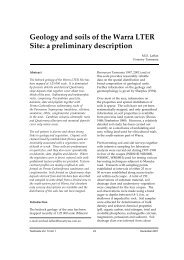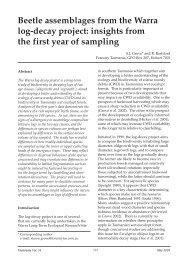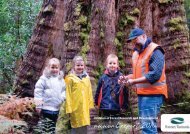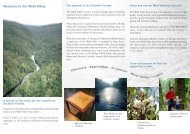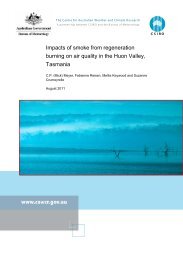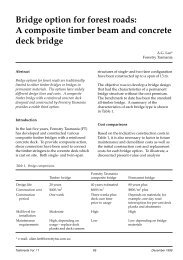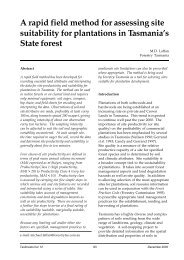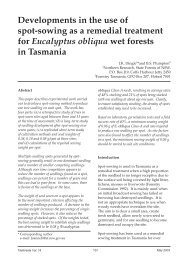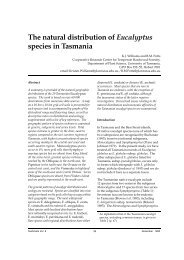sustainable forest management - Forestry Tasmania
sustainable forest management - Forestry Tasmania
sustainable forest management - Forestry Tasmania
Create successful ePaper yourself
Turn your PDF publications into a flip-book with our unique Google optimized e-Paper software.
Successful plantation establishment<br />
The successful establishment of a plantation starts with<br />
growing of high quality seedlings. Over the past two years<br />
<strong>Forestry</strong> <strong>Tasmania</strong> has invested $1.4 million on renovations<br />
to the Forest Nursery and Seed Centre which has included<br />
the installation of a new glasshouse which will benefit<br />
<strong>Forestry</strong> <strong>Tasmania</strong> and its business partners through<br />
increased capacity and reliability.<br />
The new state-of-the art germination facility has provided<br />
the nursery with 2600 square metres of growing space or<br />
enough room for 1.3 million eucalypt plantation seedlings<br />
at any one time. The installed technology enables seedlings<br />
to germinate and grow at a more even pace that allows<br />
for peak productivity and substantiality reduces the need<br />
for the time-consuming task of manually sorting seedlings<br />
according to their growth stages.<br />
Following planting out in the field, survival surveys are<br />
carried out initially at nine to 12 months to determine the<br />
percentage of seedlings that have survived and whether<br />
any refill planting is required to meet target stocking. A<br />
further survey is conducted by age two to determine<br />
the plantation area successfully established. Figure 13<br />
illustrates there is a consistently high percentage survival<br />
rate in our plantation estate. The challenges for plantation<br />
establishment in these early years include damage from<br />
insect and animal browsing, frost incidents, drought and<br />
weed competition. Further detail on the <strong>management</strong><br />
of these damage agents has been provided in the Forest<br />
Health section of this report.<br />
Strategic use of fertilisers<br />
Meeting pruned wood targets<br />
Many <strong>Tasmania</strong>n soils are low in several key nutrients<br />
In order to meet <strong>Forestry</strong> <strong>Tasmania</strong>’s requirement for high<br />
required for long term <strong>sustainable</strong> timber production from quality eucalypt sawlogs and veneer logs, plantations<br />
plantations. Sites are examined to determine which (if any) need to be pruned to grow clear-wood (knot-free timber).<br />
fertilisers are required and a program put in place to ensure Pruning occurs in one to three lifts, to a target height in<br />
the trees receive the essential nutrients for proper growth line with industry requirements. Recent data shows that<br />
and development. Most sites receive an initial fertiliser<br />
not only is the percentage of the area pruned increasing<br />
application at planting. This involves hand application of<br />
over time, but that pruning is being done at an earlier<br />
nitrogen and phosphorus, with copper where required.<br />
age, due to improvements in growth rates of the younger<br />
Secondary (or later age fertilising) generally involves the<br />
plantations.<br />
aerial application of nitrogen or a combination of nitrogen<br />
Figure 13. % Area successfully established by age two<br />
and phosphorus. Table 7 illustrates the areas that received<br />
Figure 13. % Area successfully established by age two<br />
110<br />
secondary fertilising in <strong>Forestry</strong> <strong>Tasmania</strong>’s plantation<br />
estate.<br />
100<br />
<strong>Forestry</strong> <strong>Tasmania</strong> research staff continually review the<br />
products in use and application techniques, in line with<br />
Australian <strong>Forestry</strong> Standard requirements, to favour<br />
cost effective methods with reduced outcomes on the<br />
environment. In addition, site preparation techniques for<br />
second rotation sites are continually being improved to<br />
maximise nutrient retention on sites, so as to minimise<br />
fertiliser.<br />
90<br />
80<br />
70<br />
60<br />
50<br />
2003 2004 2005 2006 2007<br />
Reporting Year<br />
Table 7. Percentage area identified for secondary (aerial) fertilising that was fertilised*<br />
Reporting Year 2005 2006 2007 2008<br />
Area Fertilised 4137 ha 2011 ha 2522 ha 3562 ha<br />
% Area Fertilised 100% 100% 100% 100%<br />
* The figures in this table are per calendar year and not financial reporting year as per the figures in this report.<br />
% Survival<br />
23




